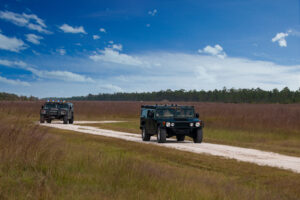Lockheed Martin [LMT] on Tuesday detailed a recent successful demonstration to bring 5G communications capability to ground vehicles, with plans to try another demonstration at the Army’s next Project Convergence that would bring in an unmanned aerial vehicle for expanded connectivity.
David Rohall, senior program manager for Lockheed Martin’s sensors and global sustainment advanced programs team, told reporters the demonstration last November was a part of the company’s ongoing 5G.MIL campaign and proved out the ability to bring advanced connectivity to ground platforms using ruggedized open architecture processors (OAP).

“[5G.MIL] is a large investment in the future for all of our joint warfighters. This technology will advance and bring new capabilities to our airmen, soldiers, Marines, sailors across all the joint domain operations,” Rohall said. “This is important for the ground vehicle domain because as more and more capabilities come to our combat vehicles there’s limited space claims on those vehicles. If we can bring more capabilities within that same space claim that is a key enabler for bringing more advanced technologies and capabilities to our soldiers.”
The demonstration at Lockheed’s Martin’s Electronics Test Site Range in Orlando, Florida involved equipping two commercial Hummers with OAPs running commercial 5G cards and connecting the two vehicles via a commercial 5G network to provide high-bandwidth, low-latency communications capability.
The 5G connectivity was then tested while the vehicles were stationary and on-the-move, with direct line-of-sight and while in obstructed fields of view and while moving at different speeds and direction, with data collected on bandwidth capacity, latency levels and signal-to-noise ratio, according to Rohall.
“We proved that we could bring 5G to the OAP processor, again that’s a flexible processor that can be upgraded over time because it’s based on commercial standards. So that was proven that we can absolutely do that,” Rohall said. “We did prove that the [5G] network did demonstrate low-latency, high-bandwidth communications in a secure environment. That’s very important from the ‘crawl’ phase to show we can bring that technology to the next phase.”
Rohall said he believed the demonstration completed the initial ‘crawl’ phase for 5G.MIL in the ground vehicle space, with research and development work this year focused on bringing this work into a capabilities-based approach.
“In 2022, we are working on taking those two Hummers, bringing new software applications to it to enable better situational awareness on the battlefield,” Rohall said.
Lockheed Martin has submitted an application to the Army to conduct an additional experiment at its next Project Convergence demonstration this fall to expand the demonstration with additional assets for advanced 5G connectivity capabilities.
“We’re also working with unmanned aerial vehicles. So the ‘crawl’ phase was bringing in a commercial network. We’re actually going to provide our own network with the 5G on a Lockheed Martin Space asset. An unmanned aerial vehicle will provide the comms between the two nodes out there on the OAPs. And then we’re also taking an unmanned aerial vehicle with a sensor on it and being able to task that sensor out to the potential point of launch of that and send back real-time video back to those two OAPs, so they can see exactly what is at that location,” Rohall said of the potential demonstration at Project Convergence.
Lockheed Martin said last month it’s working with Microsoft [MSFT] to further advance 5G networking technologies for the tactical edge of the future battlespace, noting the two companies have already demonstrated connectivity between tactical networking assets and Microsoft’s cloud services (Defense Daily, Feb. 28).